
JULIA LEE BARCLAY-MORTON – YOGA, WATER AND REWRITING AUTISM
I interviewed writer Julia Lee Barclay-Morton about her experience of autism. Julia began as an experimental dramatist in New York, moving to the UK to
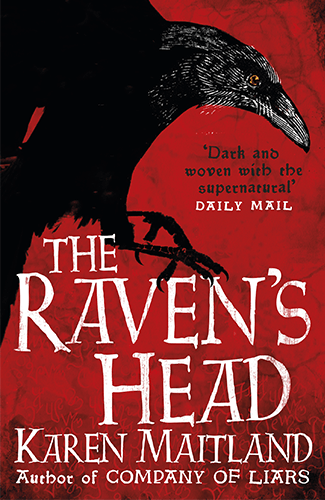
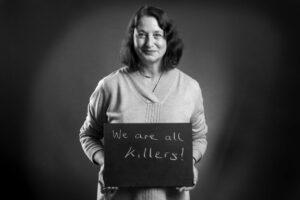
Continuing my interview with well-known novelist Karen Maitland, I asked her about writing collectively and how her studies and personal interests have contributed to her books. Karen is an authority on ’hidden’ medieval history and has several historical thrillers published by Penguin and Headline.
Leslie: You are a member of the Medieval Murderers authors’ group. How did that involvement begin and develop? What were the differences in writing a shared book, HILL OF BONES, as opposed to sole authorship?
Karen: The Medieval Murderers began as group of authors who felt that novelists reading from their books at festivals can be tedious for the audience. If the audience has already read the novel, what’s point? And if they haven’t read it, unlike a poem which is complete, an extract from a novel often doesn’t make much sense. So the historical novelists Philip Gooden, Susanna Gregory, Michael Jecks, Bernard Knight and Ian Morson felt that forming a performance group where the authors chatted to each other about writing and shared stories about researching the Middle Ages would be more entertaining and informative. I found myself sharing a platform with Mike at one festival and we discovered we worked well together, so he invited me to join. The books grew out of that performance group. There was only supposed to be one, but the Medieval Murderers ended up writing ten joint novels. The last was THE DEADLIEST SIN, which took as its theme a contest between medieval pilgrims to prove which was the worst of the ten deadly sins.
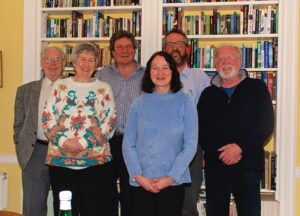
For most of the novels one of us would come up with an object or place that could pass down through time. Each author wrote a historical murder-mystery novella about it set in our own favourite time period from Saxon up to Elizabethan, with one of us writing a prologue in which the object was created and another author writing the epilogue which brought the object into the modern day with a final murder or twist.
Since we all wrote at the same time without knowing what each other were writing, unlike a sole authorship novel we had to come up with an ending for each of our novellas before we’d even worked out our plot. We had to be able to tell the author who would come after us when and where the object would be left at the end of our story, so that one of their characters could find or steal it. In THE SACRED STONE the object was a meteorite which was said to having healing powers. Bernard Knight told me that at the end of his story the stone would end up in peasant’s cottage in Shebbear, Devon in 1236, whereas I told the next author I going to leave the stone in Norwich in 1241. Having committed yourself to ending of the story, you then had to dream up a crime story which fitted it. Of course, another constraint was that you couldn’t destroy the object in the course of your story or even damage it too much, otherwise it changed it for the authors who come after you.
In common with most thriller and crime writers I don’t usually know the ending of my solo novels until I get there. So the Medieval Murderers books were a wonderful creative challenge, but strange because while we were writing those, emails flew back and forth as we checked details of the object or place. But when I write my solo novels, I don’t talk much about what I’m writing until the first draft is done. Talking about it tends to destroy it.
Leslie: You have a honours degree in Human Communication and doctorate in Psycholinguistics. How have these disciplines informed/inspired your writing?
Karen: They have made me more aware of language and how we use it, including the choices speakers make in selecting words and the way they can betray their true feelings in the little words they don’t consciously think about, like pronouns, which reveal so much about what they think about themselves and about others.
![The-Gallows-Curse-cover-large[1]](https://leslietate.com/wp-content/uploads/2018/05/The-Gallows-Curse-cover-large1-195x300.jpg) Psychology has been really important in helping me to create characters. In THE GALLOWS CURSE, one of the characters was castrated as a boy and I did a lot of research before writing the novel about what psychological effect that would have had on him as a child and also as a man. It also helps to understand why characters behave as they do, which can stimulate ideas for memories and incidents from earlier in their life.
Psychology has been really important in helping me to create characters. In THE GALLOWS CURSE, one of the characters was castrated as a boy and I did a lot of research before writing the novel about what psychological effect that would have had on him as a child and also as a man. It also helps to understand why characters behave as they do, which can stimulate ideas for memories and incidents from earlier in their life.
Leslie: Where does your love of animals come from and what roles do animals play in your books?
Karen: I didn’t have pets as a child, but I’ve made up for it since. I was lucky enough to work in Nigeria and there found myself being given a whole range of orphaned and sick animals – a chameleon, a baby duiker, a bush cat and a bat that couldn’t hang itself upside down. I even babysat lion cubs. For my novel FALCONS OF FIRE AND ICE I learned to handle birds of prey because one the main characters is the daughter of a falconer during the time of the Portuguese Inquisition.
In medieval times, animals were hugely symbolic. The Church used them as walking parables, but because of their association with the old gods, animals and birds were also steeped in folklore. Witches were thought to be able to take the form of hares or foxes. Seagulls were said to be the spirits of drowned fishermen and sailors.
I love weaving animals and birds into my books. They add layers of meaning and symbolism, because the power of creatures like the wolf and hare resonate in our culture even today. Curiously though I am not always aware of what I’ve done until I’ve finished the first draft. It’s as if the animals creep into the story at a subliminal level, crouching there in the shadows of the words until I notice them and think where did you come from and how did you get in there? All of my British books covers have had an animal or bird on there somewhere.
![Company-of-Liars-cover-large[1]](https://leslietate.com/wp-content/uploads/2018/05/Company-of-Liars-cover-large1-195x300.jpg) Leslie: COMPANY OF LIARS seems to have been a breakthrough novel for you. Can you describe its conception and execution?
Leslie: COMPANY OF LIARS seems to have been a breakthrough novel for you. Can you describe its conception and execution?
Karen: The idea for the novel came about when I was commissioned to go on tour with Indian dancers and English storytellers and to write about their show and the remote rural places they were performing in. Travelling on the road in the dark in the middle of winter, made me imagine what it must been like for the medieval itinerants who earned their living wandering for place to place, never knowing what they were walking into.
Lots of novels had been written about the plague, but always from the point of view of people living in a town or village, but I was interested in those people who were shut out of the towns when they closed their gates to strangers, those who were trying to outrun the plague. What if they discovered something even more deadly was travelling with them?
Camelot, the main character-narrator of COMPANY OF LIARS, was actually originally created for another novel I was already writing in which this old peddler was only supposed to deliver the prologue and epilogue. But then something strange happened, as I started to think about Camelot’s backstory, it was as if that person was standing at my shoulder, demanding that I write their story. The voice was so insistent that I had to temporarily stop writing that novel and write COMPANY OF LIARS instead.
By the way, the title, COMPANY OF LIARS, comes from my belief that we all of us present different facets of ourselves to different people, we never tell the whole truth about ourselves to anyone. There is always some dark thought or memory somewhere in the recesses of our mind that we haven’t ever told anyone. So in that sense no ever tells the whole truth. We are our own inventions.
Leslie: THE RAVEN’S HEAD is one of your recent novels. What are its defining characteristics as a story and what areas of experience does it explore?
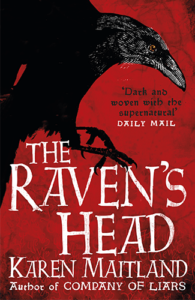 Karen: Ideas for my novels always come from something that is happening currently in the news. In this case it was the issue of ‘spin-doctors’ and they had spin-doctors in the Middle Ages too. In the time of the Crusades, rumours began to spread that Godfrey of Bouillon, Knight Commander of Jerusalem was base-born, so Godfrey commissioned a jongleur to invent a cover story that would explain that while he was of noble birth, there was no traceable family linage. In THE RAVEN’S HEAD, I imagined a lad who thinks this might be an easy way of earning a living, except that he first blackmails his victims so they are forced to commission him to invent a story for them.
Karen: Ideas for my novels always come from something that is happening currently in the news. In this case it was the issue of ‘spin-doctors’ and they had spin-doctors in the Middle Ages too. In the time of the Crusades, rumours began to spread that Godfrey of Bouillon, Knight Commander of Jerusalem was base-born, so Godfrey commissioned a jongleur to invent a cover story that would explain that while he was of noble birth, there was no traceable family linage. In THE RAVEN’S HEAD, I imagined a lad who thinks this might be an easy way of earning a living, except that he first blackmails his victims so they are forced to commission him to invent a story for them.
Two of the main characters in the novel are medieval alchemists, the raven’s head being the symbol of death and putrefaction in alchemy. Alchemy has always fascinated me, partly because of its wonderful dark symbolism and the fact that they often used human body parts in the quest for the elixir or a stone which would, among other things, prevent humans aging and dying. Unlimited wealth, stopping aging and death – it seems to me the goals of science haven’t changed at all.
The story is told using a device I love by having three different point-of-view characters whose stories at the beginning seem to have nothing to do with each other, but which gradually converge, so that their lives finally melt together in the crucible of the dark dungeons of the alchemist laboratory.
Leslie: Why do you write?
Karen: Because I can’t not write. Even when I was a tiny child, I loved being put to bed so that I could lie in the dark and tell myself stories, often serials that would go on for weeks.
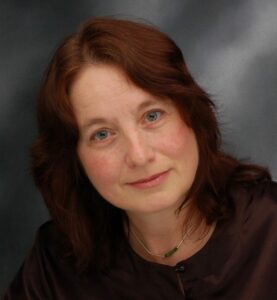
But I also write because I want to give a voice to the voiceless. I can’t bear the idea of people having lived and died without a trace, so though my characters are fictional, they represent groups of people that have been almost erased from history as if they never lived – the beguines; the castrati; the homosexuals who were punished by mutilation and death; the dwarfs who were bought and sold like animals; the cunning women; the boys kept in brothels and the ordinary poor villagers who were laid in unmarked graves. Their lives were just as fascinating as those of the kings and queens. I want to tell their stories and say ‘Look at these people from our past. Remember them. They lived and struggled, wept and laughed, felt the sun on the faces and pain in the bones just as keenly as you and I – don’t let them ever be forgotten’.
You can read an interview with Karen, featuring her most recent book ‘A Gathering of Ghosts’ here.
ABOUT LESLIE TATE’S BOOKS:

I interviewed writer Julia Lee Barclay-Morton about her experience of autism. Julia began as an experimental dramatist in New York, moving to the UK to

I interviewed Gillean McDougall from Glasgow, who edited the collaborative projects Honest Error (on Charles Rennie Mackintosh and his wife Margaret Macdonald) and Writing the

I interviewed French writer Delphine de Vigan, whose book, No et moi, won the prestigious Prix des libraires. Other books of hers have won a clutch

I interviewed Joanne Limburg whose poetry collection Feminismo was shortlisted for the Forward Prize for Best First Collection; another collection, Paraphernalia, was a Poetry Book Society Recommendation. Joanne

I interviewed Katherine Magnoli about The Adventures of KatGirl, her book about a wheelchair heroine, and Katherine’s journey from low self-esteem into authorial/radio success and
| Cookie | Duration | Description |
|---|---|---|
| cookielawinfo-checkbox-analytics | 11 months | This cookie is set by GDPR Cookie Consent plugin. The cookie is used to store the user consent for the cookies in the category "Analytics". |
| cookielawinfo-checkbox-functional | 11 months | The cookie is set by GDPR cookie consent to record the user consent for the cookies in the category "Functional". |
| cookielawinfo-checkbox-necessary | 11 months | This cookie is set by GDPR Cookie Consent plugin. The cookies is used to store the user consent for the cookies in the category "Necessary". |
| cookielawinfo-checkbox-others | 11 months | This cookie is set by GDPR Cookie Consent plugin. The cookie is used to store the user consent for the cookies in the category "Other. |
| cookielawinfo-checkbox-performance | 11 months | This cookie is set by GDPR Cookie Consent plugin. The cookie is used to store the user consent for the cookies in the category "Performance". |
| viewed_cookie_policy | 11 months | The cookie is set by the GDPR Cookie Consent plugin and is used to store whether or not user has consented to the use of cookies. It does not store any personal data. |
4 responses
Gorgeous covers!
Nice to meet Karen 🙂
A fascinating second part of the interview. I love the sound of the collaborative writing and learning about the origin of the stories. All the best to Karen and much success. And happy 2019, Leslie!
Happy New Year Olga! Leslie xx